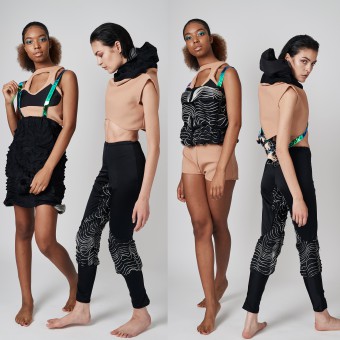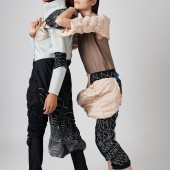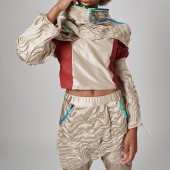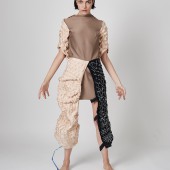
| THE AWARD |
| CATEGORIES |
| REGISTRATION |
| SUBMIT YOUR WORK |
| ENTRY INSTRUCTIONS |
| TERMS & CONDITIONS |
| PUBLICATIONS |
| DATES & FEES |
| METHODOLOGY |
| CONTACT |
| WINNERS |
| PRESS ROOM |
| GET INVOLVED |
| DESIGN PRIZE |
| DESIGN STORE |
| THE AWARD | JURY | CATEGORIES | REGISTRATION | PRESS | WINNERS | PUBLICATIONS | ENTRY INSTRUCTIONS |
Materializing The Digital Transformable Fabrics 3d Printed by Valentina Favaro |
Home > Winners > Design #92045 >Interview |
 |
|
FS: What is the main principle, idea and inspiration behind your design?
VF: The inspiration is a reflection on how movement can be embodied in our urban garments through the use of programmable materials in response to the digital era. We are now living in a digital era, digital people in digital environment, and virtual is overwhelming the physical aspects of life. In opposite to these I wanted to bring awareness on materiality. In each change there has been in the material culture the reason was mainly the movement. The relation between body and movement is the main focus.
FS: What has been your main focus in designing this work? Especially what did you want to achieve?
VF: The relation between body and movement is the main focus. I needed to find a way to put together the meaning and importance of materiality with a new need for functionality, something which can enhance the movement of our body, as well as follow and represent a new life in which from morning to night we need to go to tons of different places with different needs of clothes. I wanted to go deeper in the path of programmable materials, to design something which could both follow our movements and change its shape. In the end I started capturing the movement of the body with a Kinect, and tracing it with Maya. This gave me the possibility to follow both the conceptual part and the functional one: for the first one I was able to trace the movement, to bring it from real to virtual to its materialisation into clothes; for the functionality I was able in this way to understand which movement freedom and support was needed in our clothes. All these for easiness has been divided in free different capsule collection connected each one to one activity. Finally I started printing, printing, again and again, to find the best way in which fabrics were able to start moving, I was finally programming them.
FS: What are your future plans for this award winning design?
VF: To look further into this research trying to find a way to make it easier and to follow the path of movement in the best functional way.
FS: How long did it take you to design this particular concept?
VF: it took me 5 months, in which I printed day and nights. I was often putting my alarm during night every three hours to take out a printed piece and put another one on the go.
FS: What made you design this particular type of work?
VF: My interest on looking always forward, on discovering new possibilities. And, most of all, my interest on the connection between body and movement, nevertheless my passion for materials.
FS: Where there any other designs and/or designers that helped the influence the design of your work?
VF: First of all the practitioner Christopher Guberan, focuses on the reaction of 3d printing on fabric. Guberan research is based more in general in the development of materials which can change and react. These materials are called programmable materials.
FS: How did you come up with the name for this design? What does it mean?
VF: Materializing the digital stands for the era we're living and the one we're going to live, in which virtual is becoming more present than physical. But can we imagine a world only virtual? the name wants to create a reflection on the importance which materials have for us. On the paradox that one day we'll need to transform something digital into physical.
FS: Which design tools did you use when you were working on this project?
VF: First of all, I used a Kinect to make all the part of motion capture. Then I used the software Maya to trace and analyze movements. Meanwhile studying and developing all the sketches I started experimenting with the 3d printer with flexible filaments (different shapes, materials, mechanical tensions). Finally I made all the 3ds files with solidworks and rhino.
FS: What is the role of technology in this particular design?
VF: Applying 3d printing to fabrics to create new programmable fabrics. Also, to capture the body and analyse it while moving.
FS: What are some of the challenges you faced during the design/realization of your concept?
VF: Most of all the 3d printing of each pieces and the tailoring of each garment. 3d printing on fabric is really difficult and is challenging to not ruin the fabric and at the same time find the good adherence. Also the right mechanical tension is really tricky to find together with the right filament and fabric. Finally during the tailoring you need to put all together in the best way each module printed ( since I had access only to normale 3d printer with a plate of 40 x 40 cm).
FS: How did you decide to submit your design to an international design competition?
VF: I wanted to give it a chance for creating a resonance and maybe new connection: I think it's a good way to bring it forward and meet new people with the aim of bringing programmable materials into fashion.
FS: Thank you for providing us with this opportunity to interview you.
A' Design Award and Competitions grants rights to press members and bloggers to use parts of this interview. This interview is provided as it is; DesignPRWire and A' Design Award and Competitions cannot be held responsible for the answers given by participating designers.
| SOCIAL |
| + Add to Likes / Favorites | Send to My Email | Comment | View Press-Release | Translations |





